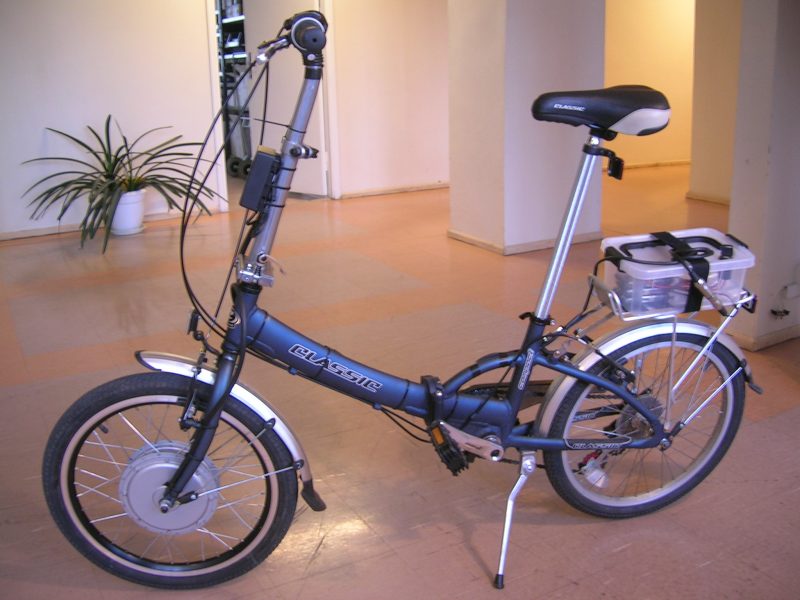
The History of the Electric Bicycle – Velobecane – Electric Bicycle
The history of the electric bike
Futuristic, modern and revolutionary electric bycicle has made amazing strides in recent years. It is suitable for cyclists of all ages, from the youngest to the elderly, who want to keep fit.
Le electric bycicle offers incredible advantages over a classic bike. This is why many brands are now taking over its design. According to statistics, this is one of the most popular motorized vehicles at the moment, so we are interested in wanting to know its true history.
If you are a fan electric bycicle, exploring the history of this avant-garde motorcycle will surely interest you. If so, let’s find out without delay in this article about Velobecane the full story. electric bycicle.
The origin of the electric bike
History electric bycicle began in 1895 in the United States. Its inventor, Odgen Bolton, came up with the idea to create a model of a "balance bike" with two in-line wheels and no pedals.
This is the very first electric bycicle then there was a patented model. It was equipped with a 10V battery mounted under the top frame tube and a 100 amp motor attached to the rear wheel.
The first appearance of a twin-engined electric bicycle
Two years after the first electric bycicle patented, in 1897 another American named Hosea W. Libby filed a second patent on his own VAE... This time, the public discovers a more technologically advanced prototype, equipped with not one engine, but two engines attached to a connecting rod system. Its inventor named it "Lampociclo".
To differ from the first model, this electric bycicle The W axle has benefited from a push-button transmission.
History electric bycicle continued and knew the incredible turning point in 1899. At that time, the world of cycling faced the first electric bycicle motor with friction technology. The device can operate independently on level tracks and requires the support of a cyclist when riding on false lines and slopes.
The success was despite some engine problems. The latter consumed so much oil and designed a lot of it. This model has been criticized for electric bycicle be too dirty. The women were not the first to accept him, as it stained their clothes.
See also: Buying guide to choose the electric bike that's right for you
Interruption of VAE production
Considering the price of oils and the impact on the environment, electric bycicle lost its popularity in the 1900s. Then the public became interested in motorcycles, which began to flood the market. Same rank as electric bycicle, the motorcycle is also equipped with an engine attached to the front wheel. It was highly regarded for its practicality and great power compared to electric bycicle.
Only people with modest incomes, who could not afford a car and motorcycle, remained faithful. electric bycicle... On the other hand, interest in more modern motorized cars that offered higher speeds was also a major reason for the decline. VAE.
Thus, several years passed before he appeared again. The oil shock of the 70s and the emergence of environmental movements gave a new impetus to production, according to research electric bycicle.
First VAE “Made in Germany”
History electric bycicle was not exclusively focused on the United States. Other countries such as Germany and the Netherlands were also exclusive producers.
In particular, for Germany, the country released its first model through the Heinzmann company at the end of the First World War. At that time, production was based on mass-produced bicycles intended mainly for postmen to provide mailing.
Netherlands, much less known as pioneers electric bicycleswere especially interested in the environmental potential of this machine. For them, it is a promising mode of transport that will reduce pollution caused by the use of vehicles.
The Yamaha brand in the history of the electric bike
After the USA, Germany and the Netherlands electric bycicle known in Asia for the Japanese brand Yamaha. We are in 1993 when this firm first launched its first electric bycicle... This is a new era that begins because Yamaha wanted to put technology at the service of its users.
The offer was then broadened, and each prototype stood out with more technical and aesthetic details. In order to expand its fame, Yamaha entered into partnerships with other brands such as Honda, Suzuki, Panasonic, Sanyo, and so on. There was a strong partnership that gave the finished product a true personality.
See also: How does an e-bike work?
Various battery technologies used in the pedal
As you know, the difference between a classic bike and electric bycicle the presence of such technical components as a motor, an electric amplifier and a battery.
Since the beginning of history, the first electric bycicle was already supplied with a 10V battery, which was installed on the frame. Although location was not the main criterion, the technology used has already piqued the interest of many manufacturers. And I must say that it changed from one model to another.
In fact, manufacturers tested a variety of technologies trying to determine which one would work best for each bike prototype and which one would satisfy the needs of users.
- Nimcho or Nickel-Metal Hybrid Battery
This battery was first released in 1990 to replace an old Ni-CD battery that was considered too harmful to the environment. The use of this new technology has been praised because it has no memory effect, provides good energy density and easily maintains changes in electrical current.
While there are significant advantages to this, manufacturers electric bicycles very rarely include it in new prototypes. The presence of potassium hydroxide makes this battery dangerous. Its use must be very safe and at the end of its useful life it must undergo major recycling.
- Rechargeable battery LiFePO4 or lithium phosphate
First electric bicycles have seen the use of a LiFePO4 battery. It was especially prized for its durability and ability to avoid the risk of fire. Among its weaknesses, the researchers found very low energy density and limited performance.
In just a few years of use, the lithium iron phosphate battery has been replaced by heavier and larger batteries.
- PB or lead battery
Lead acid batteries began to flood the market around the 2000s. electric bicycles produced during this period are equipped with it. Currently, this type of battery is still widely used to provide performance electric bicycles modern. It is especially appreciated for its reliability, cheaper components, affordable price, high energy efficiency, long lifespan, and end-of-life recyclability.
Despite its many advantages, lead acid batteries are slowly losing their popularity. We started using it less because of its memory effect, its sensitivity to low temperatures, its great loss of autonomy and especially its impressive 10kg weight. This weight does not make it any easier for cyclists, as they will have to work up the courage to pedal on a heavy bike with an overly heavy battery.
It should be noted that electric bicycles Lead acid battery accessories are not eligible for the subsidy offered by local authorities and state. If new buyers electric bicycles would you like to become a bonus recipient VAE, then when buying it is very important to think over the choice of the battery.
- Li-ion or Li-ion battery
As of 2003 electric bicycles discover the lithium-ion or lithium-ion battery. The first bicycle model equipped with this battery first appeared in Europe this year.
Compared to all other batteries, the lithium ion battery is the best of them all. It has no memory effect and provides a longer service life. It is lighter and has less self-discharge. Its very high energy density and high specific energy are also some of its many advantages.
As far as bike bonuses go, electric bicycles equipped with a lithium-ion battery can benefit from this, which cannot be said about VAE with lead acid battery.
See also: Riding an electric bike | 7 health benefits
Selling e-bikes: an undoubted success
History electric bycicle now boils down to an unprecedented feat. Sales continue to grow year after year. The European and Asian continents pioneered the use of this ecological machine.
According to polls, only in China electric bycicle is one of the most widely used two-wheelers in major urban centers. Since 2006 production electric bicycles continues to grow and registers up to three million units.
In 2010, China became a leading manufacturer of electric bycicle in the world. Municipalities and the national government have even developed a value chain associated with the production and sale of this machine. In 2013, China became not only a manufacturing country but also an exporting country for electric bicycles.
On the European continent and in particular in France, sale electric bycicle increased 25 times in 10 years. 10.000 2007 units were produced in 255.000 compared to 2017 XNUMX units in XNUMX year. Apart from the Netherlands, which have been present in history from the very beginning, other countries such as Switzerland and the United Kingdom are also starting to order electric bicycles in Asia.
In 2020, the EU imported up to 273.900 electric bicycles. These prototypes come straight from Taiwan, Vietnam and China. Many countries especially love electric bicycles Made in China. These products offer unsurpassed performance, but above all, lower cost. In demo electric bycicle Designed in China, it can travel up to 100 km on a single battery charge. Some models are limited to 20 km/h and others to 45 km/h.
Le electric bycicle therefore, it has a promising future. In addition, with new strategies implemented in many countries to combat environmental pollution and the adoption of a new alternative to cars, the production of cars of this type promises to become even more widespread.
See also: Why are folding electric bicycles good?
Some key dates in the history of the electric bike
If you are a follower electric bycicleIt is always important to know a few key dates in order to enrich your knowledge. Here are a few:
- – 3000 BC: The first bicycle wheel was made in Mesopotamia.
- 1818: Frenchman Louis-Joseph Diener files a patent for a "bicycle" named Baron Dreis.
- 1855: France discovers the first pedal bicycle, introduced by Pierre Michaud.
- 1895: Production of the first electric bycicle Ogden Bolton Jr.
- 1897: Hosea W. Libby files a second patent for electric bycicle with two motors
- 1899: Construction of the first electric bicycles with a friction motor on the tire.
- 1929 - 1950: A post-crisis period that was very favorable for electric two-wheelers.
- 1932: The great Philips brand sells the Simplex bike
- 1946: First invention of the switch by Tullio Compagnolo.
- 1993: Japanese company Yamaha introduces a dial-drive electric bicycle motor.
- 1994: Presentation of the first VAE with NiCD battery as standard on Hercules Electra
- 2003: First use of a lithium battery in electric bicycles... This year also marks the launch of the first electric bike with a carbon frame, with a Panasonic engine and a NimH battery.
- 2009: Bosch enters the market electric bicycles present their first electric motor systems
- 2015: Pragma Industries invents the first hydrogen bicycle.

